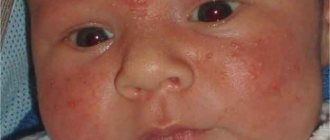Sometimes there is a sharp change in the color of stool. This can occur against the background of various pathological and physiological disorders in the body. Black stool in a child does not always indicate serious illness.
Often this condition occurs as a result of eating certain foods or taking certain medications. But you should not ignore the change in color of stool in children.
Experts identify many reasons, including dangerous ones, that can trigger the development of serious diseases.
Why can a child's stool change color?
According to statistics, dark stool in children implies the development of stomach pathologies or hemorrhage in the esophagus. This is explained by the fact that when blood is released in the upper part of the digestive system, its chemical decomposition occurs during the digestion of food.
It takes a relatively long period of time for the blood to reach the rectum, causing it to turn black. When blood is released in the lower part, the color will be bright red .
Most often, internal bleeding is not the root cause of changes in feces in childhood.
The appearance of this condition can be contributed to by various gastrointestinal diseases, individual characteristics of metabolic processes, or the food eaten.
For any changes in stool in children, you should consult a pediatrician.
Causes
There are many provoking factors that can cause a child’s stool to change color. The causes may vary in newborns and older children.
In infants
In newly born babies, the first bowel movement is called meconium. Discharge of black stool is observed on the second or third day after birth. The consistency of stool is viscous, sticky, and has no specific odor.
Meconium may consist of bile, epithelial debris, prenatal hairs, water, mucous contents, and amniotic fluid.
It is due to these components that the darkening of feces occurs.
Experts see no reason for parents to worry here.
As a rule, normalization of bowel movements occurs already on the 6th day. The color becomes yellowish-brown and the consistency becomes mushy.
The baby's digestive system has not yet formed, so the stool may remain dark in color and undigested food residues for a longer time. This occurs in most cases in premature babies.
Experts identify another reason that may contribute to dark stool coloration - individual lactose intolerance.
As a result of its inadequate digestion, irritation of the intestinal mucosa occurs, increased peristalsis and rapid passage of excrement through the intestinal canal, which contributes to their coloring black.
If lactase deficiency is noted, then, in addition to loose stools with various impurities and an unpleasant odor, such a condition will be accompanied by pain in the abdominal area, increased gas production and excessive regurgitation.
In one-year-old children
From about 10 months to 1 year, the color of stool can often change as a result of the introduction of complementary foods. This is especially true if the baby has been breastfed throughout the entire period.
The first stool may be completely consistent in color with the food that was present in the diet.
This is explained by the fact that the digestive system, which has not yet become stronger, is capable of digesting only a small part of the food entering the child’s body.
The rest of it comes out undigested along with feces.
In a one-year-old child, the stool may change color even against the background of certain foods, for example, after beet puree, bananas, apples, grapes, cherries, and animal liver.
Internal bleeding and gastrointestinal diseases as causes
In children, both newborns and 2 years of age or older, various pathological processes can contribute to the appearance of black stool.
Depending on age, the provoking factors of bleeding may be different.
Before two years of age, the following conditions are often the causes:
- Meckel's diverticulum . The anomaly is congenital and is not accompanied by characteristic clinical signs. It is possible to diagnose the disease in later stages, which occur with complications.
Intussusception . It appears at the moment when the child is introduced to complementary foods. As a result, the intestines do not always cope with new foods present in the diet. Against this background, the lumen closes and obstruction develops.- Esophageal hernia . It can appear regardless of the child’s age. Accompanied by vomiting with bloody impurities, cyanosis of the skin, rumbling, and the presence of blood in the stool.
- Duplication of the colon . Pathology also applies to congenital ones. It is detected in rare cases, but requires immediate surgery, since nearby anatomical structures may be compressed. The main sign of pathology is bleeding.
- Injury to the rectum . Cracks can appear as a result of incorrectly administered enemas, lesions due to helminthic infestations, or due to frequent constipation.
Crohn's disease . It is characterized by the development of an inflammatory process in all parts of the digestive system and the formation of ulcerative lesions. In most cases, it is detected in older children (10-18 years old).
At three years old, children often suffer from polyps, which also lead to bleeding. These are growths that form in the intestinal lumen.
The pathology is manifested by the presence of blood impurities in the stool and pain during bowel movements.
At the age of 8, black feces often appear with gastritis and ulcerative colitis. With an eroded lesion, the mucous membrane bleeds when particles of undigested food fall on it. Feces mix with blood, causing them to take on a dark color.
Adolescents are also characterized by the development of varicose veins of the stomach and esophagus, which can be triggered by increased pressure in the portal vein.
The initial stages of the disease may not manifest themselves in any way. As it progresses, there is a loss of strength of the vessel walls and bleeding.
When taking medications
Stool may become dark while taking certain medications. For example, black feces appear after activated charcoal, which is prescribed after diarrhea.
Experts explain this phenomenon by saying that the walls of the stomach do not absorb the drug, and it is excreted naturally.
For iron deficiency anemia, iron medications and vitamin complexes are often prescribed.
Due to the fact that the drugs contain an increased content of this substance, the stool turns black. In this condition, the medication is not discontinued, since this is only a side effect.
After completion of treatment, spontaneous normalization of stool is noted.
The stool may also change after taking anti-inflammatory drugs (Aspirin, Nurofen or Nimesulide).
This is due to the fact that they contain bismuth. But when taking these medications for a long time, the development of bleeding cannot be ruled out, since there is a negative effect on the gastric mucosa.
Why do children have black feces and how can you understand whether it is a disease or not?
Children of any age may periodically experience dark stool.
It may have a different consistency, and the reason for this may be a harmless diet or taking medications. But there are also situations when black feces in a child are a signal of a serious disturbance in the functioning of the gastrointestinal tract, or more precisely, of bleeding in its upper parts.
This condition is considered dangerous and requires immediate treatment.
Black spots and veins in the stool are also considered a common occurrence. And it is very important for parents to understand when it’s time to sound the alarm, and when panic is simply pointless, and you just need to slightly change the baby’s diet. There are a number of features of black feces that will help you understand the criticality of the situation, so everyone should get to know them.
Black feces in a baby in the first days of life
Immediately after birth, meconium is released from the baby’s intestines, and this phenomenon is quite natural, and it was created by nature in order to remove all microorganisms from the newborn’s body, and at this moment new ones begin to populate the intestines, those that will accompany the baby all his life . At this moment, the baby’s feces contain waste products that remain from the mother’s womb.
In children, in the first days after birth, liquid black poop is considered normal, but already on the 2nd - 3rd day of life, the feces become mushy and turn yellow.
If this does not happen, then you need to pay attention to doctors; sometimes this happens if the mother took antibiotics during childbirth, and together with her milk they entered the baby’s body.
All this can be solved, but the small organism needs help.
When should you not worry?
The child’s intestines are very sensitive, and they instantly react to any changes, both inside and outside. Therefore, in a child, black stool can be caused by a banal change in diet, or by eating a group of foods that darken the feces.
Dark-colored stools may appear due to the following foods:
- Bananas.
- Beets and their juice.
- Black currant berries.
- Prunes.
- Apples.
- Blackberry.
- Various by-products.
- Red grape varieties.
The juices from all these fruits and vegetables have the same effect, so the baby’s black stool in this case is considered normal, but there should not be the slightest change in the baby’s condition.
Important! If the darkening of feces occurs due to food intake, then this phenomenon should go away after just a few bowel movements. And parents will again see the usual yellow stool, and longer black stools are a sign of disorders in the gastrointestinal tract.
We can also say that darkening of stool is normal when the baby takes certain medications.
When considering the question of why a child has black stool, it is worth assessing whether the child is taking the following medications:
- Some multivitamin complexes.
- Sorbents.
- Antibiotics.
- Hematogen.
- Medicines containing bismuth.
If there is no fever, vomiting, weakness or other disturbances in the baby’s condition, then this phenomenon is considered normal and it will go away within a couple of weeks after taking the medications.
Black grains are also considered normal, since these are often leftover food that has not been digested or grains from berries. But it is very important that there are no mucous blood inclusions, since this is a sign of bleeding.
Black feces as a sign of disease in children
The reasons for darkening of feces may not always be harmless. And, unfortunately, sometimes specks or complete darkening are an indicator of the development of a serious disorder in the gastrointestinal tract. This is often a sign of bleeding. This phenomenon is very dangerous and may even require surgical intervention, so you should not hope that it will go away. You need to urgently call the doctors.
Black feces can be caused by several very serious pathologies:
- Ulcers of the stomach and duodenum, during which the organs are covered with wounds that bleed, and at the time of digestion of food, blood is also digested and comes out along with the feces.
- Gastritis is also accompanied by bleeding in the digestive organs.
- Mallory–Wels syndrome causes bloody mucus in a child's stool caused by damage to the mucosa due to prolonged coughing or severe vomiting.
- Diverticulitis, during which the intestinal wall protrudes.
- Gastric varicose veins also cause dark stools, this may cause the stool to become completely dark in color or there may be black particles in the stool.
- Crohn's disease, which causes pathological deep inflammation of the stomach.
- Malignant neoplasms in the large intestine lead to the release of blood.
- Fissures in the anus or internal hemorrhoids.
Often all these ailments are accompanied by negative changes in the baby’s behavior or condition. The child often experiences pain, weakness, becomes more restless and experiences nausea, possible vomiting or attacks of dizziness.
Parents should know that there is a black piece in the feces, or the absolute darkening of the feces should not immediately frighten.
But if the baby has accompanying unpleasant symptoms, then there is no need to try to treat them yourself.
Black streaks in the stool and other inclusions may be normal, but it is better for this to be determined by a doctor after a detailed diagnosis. Any disease can be cured, but you need to seek help in time.
You may also be interested in
Source: https://prosimptom.ru/az/chernyj-kal-u-rebenka.html
When to visit a specialist
In most cases, the appearance of black stool in a child is not cause for concern and does not indicate serious conditions.
When such a phenomenon is accompanied by a lack of appetite, increased moodiness, attacks of nausea and vomiting, redness of the anus, weight loss, abdominal pain and other alarming signs, it is necessary to urgently consult a doctor.
Black stool in a child: 4 reasons, help, 4 facts about baby stool in infants
Article last updated: 04/20/2018
The texture, smell, and color of stool can indicate a person's health. Therefore, when the stool suddenly turns black, this is a reason to think about the reasons for this phenomenon. Perhaps this is due to ordinary and harmless things. For example, by eating certain foods.
But it happens that black stool in a child indicates serious illnesses that require emergency medical intervention. There are also a number of chronic diseases and conditions where blackened stool is a dangerous and very suspicious symptom.
The normal color of stool ranges from yellow-brown to dark brown, and varies slightly. It depends on eating habits and personal characteristics of the body. The final color is formed due to the presence in the stool structure of products processed by intestinal bile and undigested food particles that made up the diet of a particular person in the last few days.
A breastfed baby's stool is yellow or slightly green and has a soft texture. It can be quite liquid, with a consistency similar to porridge. There are many normal shades of baby stool. One of them is a greener tint, which means that mom ate something not entirely typical of her diet. When your baby has no other symptoms, there is no reason to worry.
As a rule, every parent knows what stool color is normal for their child. Therefore, when the stool becomes unusual, it is impossible not to notice.
The very first thick, black, sticky deposits in a baby's diaper are far from the feces that will come later. Your baby's first stool is called meconium.
Meconium fills the intestines of all newborns. It gets its distinct color from bile, a fluid produced in the liver that aids digestion.
In addition to bile, meconium contains amniotic fluid, lanugo (the fine hair that covers your baby's body while inside the uterus), dead skin cells, mucus and bilirubin.
Most of these ingredients are harmless, but too much bilirubin in the blood can lead to jaundice.
Meconium stool is quickly replaced by transitional stool 3 to 5 days after birth. This stool is a little weaker and more greenish-brown in color. It is a “transition” to regular milk stool, which can be seen around the sixth day.
If your baby's stool is still black even after three days, or after transitional stool after five days, it may be a sign that the baby is not getting enough food and you should talk to your pediatrician right away.
A one-year-old's stool that looks black, tarry, or bloody can be quite scary for parents, but does not always indicate a serious illness.
Food
You don't have to worry about the occasional black stool. Black stool does not always mean there is blood in it. The color change can only be associated with the diet of a small child.
Red beets, prunes, pomegranates, red grapes, black currants, blueberries and other fruits, berries, and vegetables can change the color of the stool.
It is enough to stop eating these foods, and after a couple of days the feces will acquire a normal, familiar color.
Don't worry if you have normal-colored black inclusions in your stool—these are simply undigested food particles that have changed color in the digestive tract.
A common cause of intense concern is the presence of inclusions in the stool that look like small black worms. They are usually confused with worms and go to doctors to get tested and begin deworming. It is more likely that this is fiber from a banana eaten earlier. Real parasites have a completely different color - white or yellowish.
Medicines
Black stool may suddenly appear in an infant after taking certain medications. For example, medications used to prevent and treat anemia include iron, which gives stool that color. Vitamin complexes, medications with bismuth, and activated carbon have the same effect.
If you find that your child has black stools after using any medications, you need to carefully read the instructions for them.
It should be noted that drugs containing acetylsalicylic acid, as well as some anti-inflammatory drugs (Ibuprofen, Diclofenac) and anti-clotting agents, cannot stain the stool itself. However, their use sometimes causes internal bleeding.
Therefore, if you find black stool in a child, especially in the form of diarrhea, during treatment with these drugs, you should immediately seek medical help.
Bile
Sometimes the color of the stool is not black, but it appears so in poor lighting. This usually occurs when the baby has dark green stools due to bile and may look very dark. If this is the case, you can confirm your doubts by rubbing a piece of stool on something white or looking at it more closely under a bright light.
Gastrointestinal bleeding
When a child experiences other symptoms along with blackened stools - fever, pain, prolonged anguished crying, vomiting - this indicates bleeding in the upper gastrointestinal tract.
Various reasons that can cause bleeding:
- stomach ulcer;
- gastritis;
- Mallory-Weiss gap;
- foreign body or organ injury;
- intestinal ischemia (when blood does not properly supply the intestines);
- vascular malformation.
Every parent, when they notice black stool in their baby, begins to worry about what is causing these changes. Don't panic in advance.
Carefully study your child's diet over the past few days. If the food products mentioned above (beets, currants, pomegranates, etc.) were present, then more than likely they were the ones that colored the stool an unusual black color.
Perhaps the reason is the use of certain medications (they were also mentioned earlier). In the case where the child has recently eaten regular foods and has not taken any medications, suddenly blackened stools are likely to indicate the occurrence of a life-threatening condition.
And a visit to the doctor cannot be postponed.
Monitor the texture and color of your stool for several days. If the causes are harmless and not dangerous (for example, the use of certain foods and medications), then the stool returns to normal no more than 2 days after eliminating them. In cases where the feces have turned black due to serious illnesses, this will not happen.
Pay special attention to a child whose stool suddenly turns black. Does your baby look sick? How had he been feeling in the weeks and months prior to the blackening of his stools?
When the causes of blackening of the stool are harmless, the child’s well-being does not change, he feels healthy and full of energy.
When the occurrence of black feces is accompanied by constipation, bloating, vomiting, nausea, anemia, heartburn, abdominal pain and other suspicious painful signals, the intensity of which increases over time, it is most likely that this is a serious disease or its complications.
Black stool in babies is not necessarily a sign of illness, but you should talk to your doctor if the problem persists. The color usually returns to normal after a few days, but if it doesn't, it's time to see a doctor.
The doctor will confirm whether there is indeed blood in the stool. The specialist will also examine the outside of the anus to determine the true cause of the bleeding. Sometimes a rectal examination is performed to confirm the diagnosis.
Your doctor may recommend further testing if you are unsure about the cause of the bleeding. A colonoscopy will be ordered to examine the interior of the lower intestine.
Other facts about baby chairs that parents should know
Black stool in babies is a concern for parents, but from time to time you may notice other changes in the consistency and color of the stool.
Red chair
This is usually blood, so it makes sense to talk to your doctor, especially when this change persists. The baby may have a small crack on the inside of the anus when hard stool passes through, sometimes causing bleeding. If this is the case, your doctor will recommend drinking more fluids, prunes, and fiber to soften your stool.
Red stools may be the result of taking antibiotics that combine with iron.
Certain foods and drinks, such as red juice, can cause stool to appear colored.
Green chair
Green stool is usually the result of stool moving too quickly through a baby's intestines. This is not a cause for concern, especially in infants. But the child must gain weight well.
Green stool can also be the result of eating a lot of fiber foods (broccoli or other green vegetables). In some cases, the green color is due to the use of dyes in the food or drinks that the child consumes.
Yellow chair
In addition to black stools, the child sometimes has yellow stools. Don't worry about yellow stool if you are breastfeeding. Sometimes it looks like mustard in the diaper after feeding.
But consult a specialist if yellow stools are accompanied by abdominal pain. This may be due to inflammation or irritation in the intestines.
While gray or chalky stools are usually not a sign of abnormality, they are often the result of the child eating something unusual. You should tell your pediatrician if this occurs repeatedly. Rarely, it is associated with liver problems or another medical condition.
Thus, black stool in itself is not dangerous. But this is a possible signal of serious diseases in the body that threaten life if timely help is not provided.
On the other hand, this is often explained by the banal consumption of certain foods that turn the stool an unusual color. In any case, do not be squeamish when studying the condition of your child’s stool.
Nature is intelligent - it has provided a whole system of signs and signals that make a person wonder whether his body is in order.
Source: https://kroha.info/health/disease/u-rebenka-pochernel-stul
Methods for normalizing stool
If dark stools were caused by eating certain foods, then it is enough to exclude them from the child’s diet.
When the cause is a disease or bleeding, drug therapy is used.
Surgery is required to eliminate hemorrhages.
Treatment of chronic pathologies of the digestive system is based on taking medications such as antibiotics for the intestines, anti-inflammatory drugs, as well as medications whose action is aimed at reducing the acidity of gastric juice.











